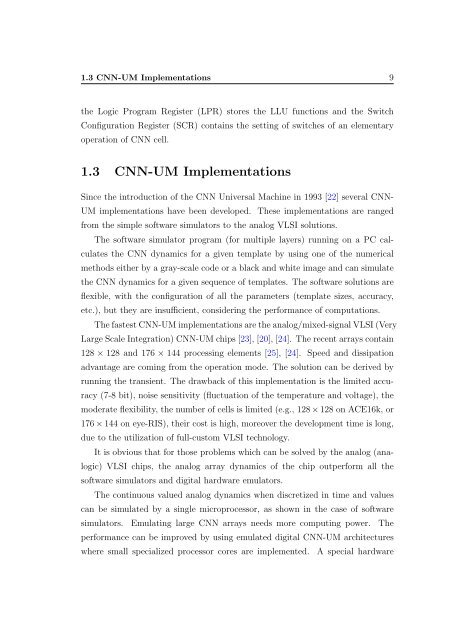PPKE ITK PhD and MPhil Thesis Classes
PPKE ITK PhD and MPhil Thesis Classes
PPKE ITK PhD and MPhil Thesis Classes
You also want an ePaper? Increase the reach of your titles
YUMPU automatically turns print PDFs into web optimized ePapers that Google loves.
1.3 CNN-UM Implementations 9<br />
the Logic Program Register (LPR) stores the LLU functions <strong>and</strong> the Switch<br />
Configuration Register (SCR) contains the setting of switches of an elementary<br />
operation of CNN cell.<br />
1.3 CNN-UM Implementations<br />
Since the introduction of the CNN Universal Machine in 1993 [22] several CNN-<br />
UM implementations have been developed. These implementations are ranged<br />
from the simple software simulators to the analog VLSI solutions.<br />
The software simulator program (for multiple layers) running on a PC calculates<br />
the CNN dynamics for a given template by using one of the numerical<br />
methods either by a gray-scale code or a black <strong>and</strong> white image <strong>and</strong> can simulate<br />
the CNN dynamics for a given sequence of templates. The software solutions are<br />
flexible, with the configuration of all the parameters (template sizes, accuracy,<br />
etc.), but they are insufficient, considering the performance of computations.<br />
The fastest CNN-UM implementations are the analog/mixed-signal VLSI (Very<br />
Large Scale Integration) CNN-UM chips [23], [20], [24]. The recent arrays contain<br />
128 × 128 <strong>and</strong> 176 × 144 processing elements [25], [24]. Speed <strong>and</strong> dissipation<br />
advantage are coming from the operation mode. The solution can be derived by<br />
running the transient. The drawback of this implementation is the limited accuracy<br />
(7-8 bit), noise sensitivity (fluctuation of the temperature <strong>and</strong> voltage), the<br />
moderate flexibility, the number of cells is limited (e.g., 128 × 128 on ACE16k, or<br />
176 × 144 on eye-RIS), their cost is high, moreover the development time is long,<br />
due to the utilization of full-custom VLSI technology.<br />
It is obvious that for those problems which can be solved by the analog (analogic)<br />
VLSI chips, the analog array dynamics of the chip outperform all the<br />
software simulators <strong>and</strong> digital hardware emulators.<br />
The continuous valued analog dynamics when discretized in time <strong>and</strong> values<br />
can be simulated by a single microprocessor, as shown in the case of software<br />
simulators. Emulating large CNN arrays needs more computing power. The<br />
performance can be improved by using emulated digital CNN-UM architectures<br />
where small specialized processor cores are implemented. A special hardware






![optika tervezés [Kompatibilitási mód] - Ez itt...](https://img.yumpu.com/45881475/1/190x146/optika-tervezacs-kompatibilitasi-mad-ez-itt.jpg?quality=85)









